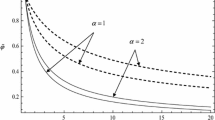Abstract
The structure of the electromagnetic field in a conducting magnetic compressed in a shock wave is analyzed. It is shown that compression of a magnetic material in an external magnetic field leads to origination of a system of two currents identical in magnitude but opposite in direction. One of them passes ahead of the shock front in the undisturbed substance, and the oppositely directed current passes over the shock‐compressed substance. As the shock wave moves further, the absolute value of current monotonically increases. The parameters determining the global electromagnetic pattern in the shock‐compressed magnetic are found. These parameters can be considered as the generalization of the governing parameters found previously by the authors for a nonmagnetic conductor. The formulated model offers a qualitative explanation for the results of dynamic experiments with an 80NKhS magnetic soft alloy. The voltage record on the specimen surface indicates effective shock‐induced demagnetization of the material.
Similar content being viewed by others
REFERENCES
E. B. Royce, “Anomalous shock-induced demagnetization of nickel ferrite,” Appl. Phys., 37, No. 11, 4066-4070 (1966).
J. E. Besancon, J. L. Champetier, Y. Leclanche, et al., “Ferromagnetic transducers,” in: H. Knoepfel and F. Herlach (eds.), Megagauss Magnetic Field Generation by Explosives and Related Experiments, Brussels (1966), pp. 331-347.
R. A. Graham, “Pressure dependence of the magnetization on invar and selectron from 30–450 kbar,” Appl. Phys., 39, No. 2, 437-439 (1968).
J. W. Shaner and E. B. Royce, “Shock-induced demagnetization of YIG,” Appl. Phys., 39, No. 2, 492-495(1968).
R. C. Wayne, “Effect of hydrostatic and shock-wave compression on the magnetization of a 31.4 at.% NiFe alloy,” Appl. Phys., 40, No. 1, 15-22 (1969).
J. Y. Wong, “Double-shock method for detecting pressure limits of magnetic phase transitions,” Appl. Phys., 40, No. 4, 1789-1791 (1969).
R. N. Keeler and A. C. Mitchell, “Electrical conductivity, demagnetization and the high-pressure phase transition in shock-compressed iron,” Solid State Communication, 7, 271-274 (1969).
E. B. Royce, “Properties of magnetic materials under shock compression,” in: P. Caldirola and H. Knoepfel (eds.), Physics of High Energy Density, Academic Press, New York (1971).
D. E. Grady, “Method for shock-wave investigation of magnetic materials,” Rev. Sci. Instrum., 43, No. 5, 800-804 (1972).
V. V. Novikov and V. N. Mineev, “Shock compression and magnetic effects in a ferrous magnetodielectric,” Zh. Éksp. Teor. Fiz., 67, No. 4(10), 1141-1146 (1974).
A. N. Kiselev, “Magnetic measurements in shock waves,” Combust. Expl. Shock Waves, 11, No. 6, 804-809 (1975).
R. A. Graham, Solids under High-Pressure Shock Compression, Springer-Verlag, New York (1993), p. 221.
S. C. Gilev, “Shock-induced conductivity waves in metallic samples,” Combust. Expl. Shock Waves, 31, No. 4, 500-506(1995).
S. D. Gilev, “Shock-induced conductivity waves in a conductor placed in an external magnetic field,” Combust. Expl. Shock Waves, 32, No. 6, 696-701 (1996).
S. D. Gilev and T. Yu. Mikhailova, “Current wave in shock compression of a substance in a magnetic field,” Zh. Tekh. Fiz., 66, No. 5, 1-9 (1996).
S. D. Gilev and T. Yu. Mikhailova, “Electromagnetic processes in a system of conductors formed by a shock wave,” Zh. Tekh. Fiz., 66, No. 10, 109-117(1996).
S. D. Gilev, “Current waves generated by shock compression of a condensed substance in a magnetic field,” Khim. Fiz., 17, No. 2, 38-51 (1998).
S. D. Gilev and T. Yu. Mikhailova, “Electromagnetic field and current waves in a conductor compressed by a shock wave in a magnetic field,” Combust. Expl. Shock Waves, 36, No. 6, 816-825 (2000).
S. D. Gilev, “Application of the electromagnetic model for diagnosing shock-wave processes in metals,” Combust. Expl. Shock Waves, 37, No. 2, 230-235 (2001)
S. D. Gilev and T. Yu. Mikhailova, “Electromagnetic field under shock compression of a current-carrying conductor,” Zh. Tekh. Fiz., 72, No. 7, 21-27 (2002).
E. I. Bichenkov, “Electromagnetic field and current waves generated by a shock wave entering a conductor with a transverse magnetic field,” J. Appl. Mech. Tech. Phys., 38, No. 2, 185-191 (1997).
E. I. Bichenkov, “Electrodynamic effects accompanying the propagation of current-carrying shock waves in a transverse magnetic field,” Combust. Expl. Shock Waves, 36, No. 6, 809-815 (2000).
I. E. Tamm, Fundamentals of the Theory of Electricity [in Russian], Nauka, Moscow (1989).
J. M. Burgers, “Penetration of a shock wave into a magnetic field,” in: R. K. M. Landshoff (ed.), Magnetohydrodynamics (Symposium), Stanford University Press, Stanford, California(1957), pp. 36-56.
E. I. Zababakhin and M. N. Nechaev, “Shock waves of the field and their cumulation,” Zh. Éksp. Teor. Fiz., 33, No. 2 (8), 442-450 (1957).
S. I. Pai, Magnetogasdynamics and Plasma Physics, Springer-Verlag, Wien (1962).
A. G. Kulikovskii and G. A. Lyubimov, Magnetic Hydrodynamics [in Russian], Fizmatgiz, Moscow (1962).
H. Knoepfel, Pulsed High Magnetic Fields, North-Holland Publ. Co., Amsterdam (1970).
Yu. V. Koritskii, V. V. Pasynkov, and B. M. Tareev (eds.), Handbook on Electrotechnical Materials [in Russian], Energoatomizdat, Leningrad (1988).
R. N. Keeler, “Electrical conductivity of condensed media at high pressures,” P. Caldirola and H. Knoepfel (eds.), Physics of High Energy Density, Academic Press, New York (1971), pp. 106-125.
J. J. Dick and D. L. Styris, “Electrical resistivity of silver foils under unaxial shock-wave compression,” J. Appl. Phys., 46, No. 4, 1602-1617 (1975).
F. A. Baum, L. P. Orlenko, K. P. Stanyukovich, R. P. Chelyshev, and B. I. Shekhter, Physics of Explosion [in Russian], Nauka, Moscow (1975).
Author information
Authors and Affiliations
Rights and permissions
About this article
Cite this article
Gilev, S.D., Mikhailova, T.Y. Electromagnetic Field Formed by Shock Compression of a Conducting Magnetic. Combustion, Explosion, and Shock Waves 39, 704–714 (2003). https://doi.org/10.1023/B:CESW.0000007685.61749.a9
Issue Date:
DOI: https://doi.org/10.1023/B:CESW.0000007685.61749.a9



